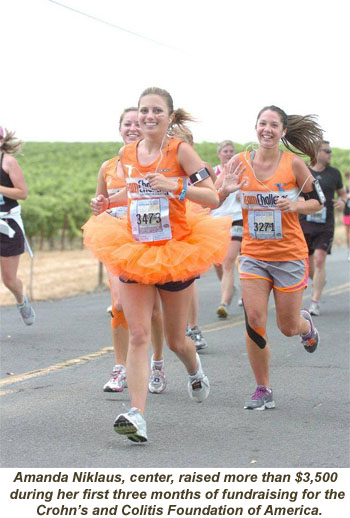Exploring Advocacy: How to join and persevere for a cause

As we examine advocacy in associations this month, we asked our peers how they advocate for their organizations, and about the challenges and opportunities they face.
Chatting up a hairstylist, rushing across the finish line of a half marathon, and corralling 400 youths at the Texas State Capitol may not seem like groundbreaking ways to further a cause. For three young professionals across the United States, however, these activities are an integral part of the advocacy work they conduct for causes close to their hearts. As we examine advocacy in associations this month, we asked our peers how they advocate for their organizations, and about the challenges and opportunities they face.

![]()
|
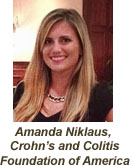 Amanda Niklaus, a public relations and social media manager, silently suffered from Crohn’s disease for 15 years. Crohn’s disease is a chronic inflammatory condition of the gastrointestinal tract. Niklaus kept quiet about her condition out of embarrassment and not knowing what she, as an individual, could do to help others with Crohn’s until she saw a flyer on her GI doctor’s wall for the Crohn’s and Colitis Foundation of America (CCFA) a few years ago. “I had heard about the foundation in the past, but until then didn’t have the “guts” to get involved. It was the best decision I ever made,” she said.
Amanda Niklaus, a public relations and social media manager, silently suffered from Crohn’s disease for 15 years. Crohn’s disease is a chronic inflammatory condition of the gastrointestinal tract. Niklaus kept quiet about her condition out of embarrassment and not knowing what she, as an individual, could do to help others with Crohn’s until she saw a flyer on her GI doctor’s wall for the Crohn’s and Colitis Foundation of America (CCFA) a few years ago. “I had heard about the foundation in the past, but until then didn’t have the “guts” to get involved. It was the best decision I ever made,” she said.
A week after her appointment she attended an informational meeting for CCFA’s endurance training/fundraising program and signed up to raise money by running a half marathon on the spot. During her first three months of working on behalf of CCFA, she raised more than $3,500 to help find a cure for Crohn’s disease and ulcerative colitis, a related GI condition.
Similar to Niklaus’s wish to help others in her situation, Lydia Domaruk became involved with the Central Texas Afterschool Network (CTAN) in 2007 as a result of her desire to help cultivate better after-school programs for her kids and their peers. Domaruk started working with youth when she was still a teenager herself and “never looked back,” she said. Her graduate degree is in recreation, parks and tourism sciences from Texas A&M University with an emphasis on youth development. Domaruk works for the 4-H CAPITAL after-school program in Travis County, Texas, and volunteers with CTAN in her free time.
CTAN is a membership organization that helps private and non-profit organizations in central Texas, collaborate to serve school-age children and their families during out-of-school time. CTAN’s mission is to expand out-of-school time opportunities for children, youth and families that are diverse, accessible, balanced and of the highest quality.
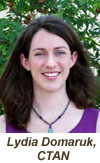 “I first became involved in CTAN as a volunteer for its annual Breakfast of Champions event. This event highlights local leaders for out-of-school time. I served on the decorations committee. Within two years I was co-chairing the annual CTAN University conference, and within four years, I had been appointed president-elect. I am currently serving my third year on the executive committee as past president,” said Domaruk.
“I first became involved in CTAN as a volunteer for its annual Breakfast of Champions event. This event highlights local leaders for out-of-school time. I served on the decorations committee. Within two years I was co-chairing the annual CTAN University conference, and within four years, I had been appointed president-elect. I am currently serving my third year on the executive committee as past president,” said Domaruk.
Advocacy in your day job
Advocacy isn’t always conducted on a volunteer basis: Jessica Peters, a contracting archivist working with National Park Service records at the Intermountain Region Museum Service Program, has made advocating for her field part of her daily job responsibilities.Archivists and records managers maintain compliance and preserve information for the future. Peters became an advocate for professional archivists when she attended graduate school to become an archivist and took a class with an enthusiastic professor:
“One professor did a wonderful job of making us ‘activist archivists’ and instilling in us a sense of duty to advocate for the field,” she said. “My cohort took this mentality to heart. During our first semester, we wrote an elevator speech that explained archival work. The idea was to in five sentences (about the time you would have in an elevator) tell someone what and archivist is and does. This was a great exercise for clearly articulating what we do and why it is important without boring the person you are talking to.”
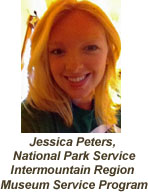 In addition to polishing their professional pitches, Peters and her classmates created a bulletin board in their history department’s building (of which her program was a part) to display what they were learning. The end goal was to reach out to the non-archives graduate students. Since her classroom days, Peters has spread the word about the importance of her profession to a wider network.
In addition to polishing their professional pitches, Peters and her classmates created a bulletin board in their history department’s building (of which her program was a part) to display what they were learning. The end goal was to reach out to the non-archives graduate students. Since her classroom days, Peters has spread the word about the importance of her profession to a wider network.
“I use every opportunity to advocate for my profession no matter who is asking. The hairstylist, the car salesperson, a friend of a friend: If those people are more aware of this field, when they hear [the term] “archives” in a budget or political discussion, maybe they will remember what that is and that it is important,” she said.
Running and fundraising soon led Niklaus to a full-time position with CCFA, where for three years she spoke on behalf of the foundation to pharmaceutical companies and support groups. Her goal was to dispel misconceptions about the disease and to increase awareness of its cause to patients, health care providers and the general population. Though she is no longer employed by CCFA, Niklaus still raises money by running half and full marathons in support of CCFA. She also works with her current employer to plan fundraising events and activities to support the foundation.
Advocating for a cause can take many forms. For all three women, educational activities are the most frequent way they make their point.
For Domaruk, advocating for CTAN involves a lot of education and communication with local and state leaders who have the power to make long-lasting policy changes that affect resources and time devoted to after-school and summer programs.
“As an organization, we communicate with school districts, city council members, county commissioners and other community leaders about the need for out-of-school-time programs,” said Domaruk. “For example, we just hosted a local National Summer Learning Day event at the state Capitol. More than 400 youths from 10 different organizations came to the Capitol to share their summer camp experiences with state legislators. We were there to share about the importance of summer learning in preventing high rates of summer learning loss in our community. Our legislators need to know about existing programs and funding sources and what the threats are to our success.”
Peters agreed with the primacy of educating others about your cause. “We need other professions like legal, IT and departments within our organizations to understand what archivists do and in what ways we contribute to the organization. If people do not know that these information resources are available to them, and the importance of preserving information for future generations, then funding will decline and the profession and information preservation could suffer.”
“By educating your audience, they in turn can educate others,” Domaruk stressed.
Overcoming advocacy obstacles
Advocating for a cause comes with challenges, whether that is correcting misperceptions or spurring others into actions that will help further the cause. Creating awareness about the cause is often the most difficult work.
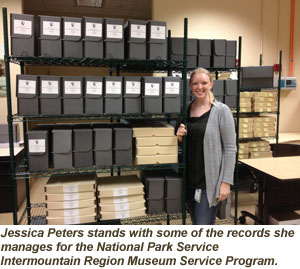 “Some of my biggest challenges in advocating for the CCFA are the general lack of awareness about the diseases we are fighting to cure,” said Niklaus. “It’s an embarrassing subject that most patients prefer not to talk about, so creating that awareness … is the most important yet most challenging piece of the puzzle,” she said.
“Some of my biggest challenges in advocating for the CCFA are the general lack of awareness about the diseases we are fighting to cure,” said Niklaus. “It’s an embarrassing subject that most patients prefer not to talk about, so creating that awareness … is the most important yet most challenging piece of the puzzle,” she said.
Likewise, Peters spends a large portion of her time reaching out to others to make them aware of the importance of archival work and encouraging others to enter the field.
“I started a blog (CommentsForTheRecord.wordpress.com) where I speak to young professionals in the field,” she explained. “I love exploring professional development opportunities and also talking about cool things I have learned. The blog pushes me to keep growing in the field. Being that my professions generally require masters degrees, I love talking with people [who are] interested in exploring the field as a potential career for themselves. There is so much I didn’t know going into the field, and it feels good to be able to pass on what I have learned and experienced to others.”
Advocacy can become a full-time job in addition to an individual’s real full-time job. Domaruk, employed full-time and a full-time mom, said it’s challenging to conduct advocacy work in addition to her other job and parental responsibilities. “Finding the time to do all things as well as I want to is difficult,” she explained. “But at CTAN, we are all volunteers and we rely heavily on each other as a team to get things done.”
As difficult as changing attitudes toward a subject can be, for Niklaus, the repetitive work is worth the end result. “It’s rewarding to know that I’m improving [others’] understanding of these diseases so that others won’t feel the need to stay silent like I did,” she said. Niklaus still volunteers every summer at CCFA’s Camp Oasis, a week-long summer camp for children suffering from Crohn’s disease and ulcerative colitis. That allows her to be a role model for younger patients.
“My biggest excitement comes from seeing the young patients benefit from CCFA’s programs, education and support. I never had that support system while growing up with the disease, so it has quickly become the most rewarding part of working on their behalf,” said Niklaus.
Domaruk agrees that advocacy work is worth the opportunities she is helping create for all children.
“I think this is a very exciting time for after-school. Across the nation, state-wide after-school networks are organizing and local groups are stepping up and claiming their role in the education system. I think policymakers across the country are beginning to realize that to create a high quality education for our nation’s youth, we have to focus not only on improving our schools, but on improving access to high quality programs after school, on weekends and during the summer,” she said. “So I look forward to my field growing professionally, and gaining more importance in the public eye.”
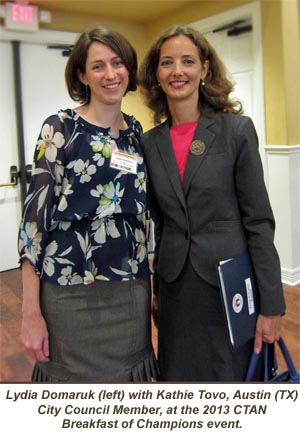 Progress toward her and CTAN’s goals is happening, too. “Recently, the Austin [Texas] City Council passed a resolution asking city employees to become further involved in CTAN’s work. Council Member Kathie Tovo spoke at a recent CTAN Executive Leadership Summit is support of the collaborative effort towards out-of-school-time system building that we are doing here in Austin,” Domaruk related. “Our hope is that with her support and others, we’ll have an audience with community leaders this spring to present our action plan for a coordinated approach to out of school time in Central Texas.”
Progress toward her and CTAN’s goals is happening, too. “Recently, the Austin [Texas] City Council passed a resolution asking city employees to become further involved in CTAN’s work. Council Member Kathie Tovo spoke at a recent CTAN Executive Leadership Summit is support of the collaborative effort towards out-of-school-time system building that we are doing here in Austin,” Domaruk related. “Our hope is that with her support and others, we’ll have an audience with community leaders this spring to present our action plan for a coordinated approach to out of school time in Central Texas.”
And for those young professionals toeing the start line for advocacy work?
“Do it!” exclaimed Niklaus. “Not only does [advocacy work] better your community, it’s an extremely empowering feeling to know that you’re changing the landscape of your community and affecting the lives of others in a positive way.”
Conclusion
Echoing this sentiment, Peters said she sees big changes in her field as a result of archivists advocating for their profession and securing the resources they need to help archiving adapt to 21st century technology. “We are gaining ground on the technological front, and I am optimistic that we will be adapting our methods. I am looking forward to so much personally and with my profession as a whole,” she said.
About the interviewees:
Lydia Domaruk is the county extension agent for Urban Youth Development in Travis County with the Texas A&M AgriLife Extension Service. She is currently serving as the past president for the Central Texas Afterschool Network.
Amanda Niklaus is a public relations and social media manager for Vixity, and she volunteers with the Crohn’s and Colitis Foundation of America.
Jessica Peters is a Western Washington University CESU project archivist for the National Park Service’s Intermountain Region Museum Services Program. Her blog about the archivist profession is CommentsForTheRecord.wordpress.com.

